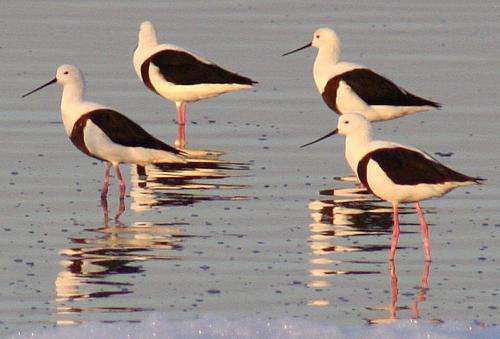October 15, 2014 report
Australian water bird found to migrate long distance when the weather dictates

Researchers with Deakin University in Australia have conducted a study of the native Australian water bird banded stilt and have found it has truly unique migration behavior. In their paper published in the journal Biology Letters, the team describes how they attached satellite transmitters to several specimens and what they learned by tracking the birds for over a year.
Banded stilts are interesting birds, of that there is no doubt—colored like penguins with humming bird like beaks, they tend to congregate on seashores. But what makes them truly interesting, is that they somehow figure out when rain has fallen very far inland on a normally dry desert and fly very quickly to the newly wet location—generally a temporary lake—nest until the lake dries up, and then fly back to the coast. While at such a lake, they feed on brine shrimp that appear only when there is water. In this new effort, the researchers monitored all this activity for the first time.
The researchers captured 21 of the stilts and attached solar powered tracking devices to their legs—that allowed for monitoring them for up to 13 months. In looking at the data, the researchers were able to follow the birds as they left the seashore and traveled sometimes very long distances (up to 1000 miles), nested and then returned. The distance is a record for a water bird, and the fact that the birds only migrate when the weather dictates makes it a one of kind. Adding to the uniqueness is it appears the birds are able to wait for two or three years to migrate if need be, putting off nesting. There's also the mystery of how they find the temporary lake—at one point, the researchers noted that two birds took off from the same site and migrated close to a thousand miles using different paths.
Despite the tracking, the researchers still have no idea how the birds know when rain has occurred so far away—though they suspect it has to do with an ability to detect low-frequency sounds or slight changes in atmospheric pressure. It's even possible that they are able to smell the newly emerging brine shrimp. In any case, the unusual migration strategy appears to pay off—it provides the birds a relatively safe place to nest—one with an abundance of food.
More information: Biol. Lett. October 2014 vol. 10 no. 10 20140547. DOI: 10.1098/rsbl.2014.0547
Journal information: Biology Letters
© 2014 Phys.org



















